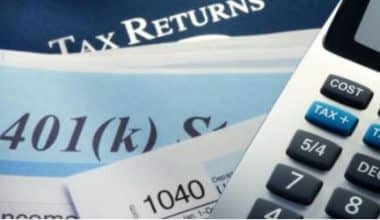As much as tax evasion is a punishable offense, there are legal ways to lower some or all of your tax obligation. Learn more on how to avoid paying taxes on savings bonds, alimony, or as an independent contractor without breaking any rules in this article.
How to Legally Avoid Paying Taxes
The IRS provides Americans with a number of tax credits and deductions that can lawfully reduce the amount on your tax. All Americans should be aware of the deductions and credits to which they are entitled; failing to do so is equivalent to leaving money on the table. Here are steps you can take to reduce your tax bill.
#1. Qualify for Tax Credits
Many individuals are unaware that a tax credit is essentially free money. Tax deductions lower the amount of taxable income you can claim, while tax credits lower the amount of tax you owe and, in many situations, result in a handsome refund.
The IRS provides a plethora of tax credits ranging from purchasing energy-efficient equipment for your home to paying health insurance premiums to living in a low- to moderate-income family. The key to taking advantage of these credits is to go over all of your purchases for the year to see if you are owed money.
Individuals can benefit from 17 tax credits divided into five categories:
- Credits for Education
- Tax breaks for families
- Credits for healthcare
- Credits for home ownership and real estate
- Credits for earnings and savings
- Consider Itemized Deductions.
Most people use the standard deduction when filing their taxes to avoid having to provide documentation of all purchases made during the year. Furthermore, itemized deductions frequently do not exceed the basic deduction.
However, if you’ve made significant payments for mortgage interest, property taxes, medical bills, local and state taxes, or significant charitable contributions, it may be worthwhile to take this step. These tax breaks are deducted from your adjusted gross income, lowering your taxable income. So, if you’re looking for ways to avoid paying property taxes or school taxes, you might be out of luck. However, you may be able to deduct them from your income and use them to avoid paying other taxes.
In only five minutes, the IRS provides an interactive tax aide that can walk you through the process of determining your general standard deduction eligibility. Determine which deduction is bigger for your tax situation: the standard deduction or an itemized list of all your expenditures and expenses.
#2. Enroll in College
Enrolling in college is one option to take advantage of tax breaks or credits. The government now provides credits and deductions — generally one or the other — for returning to school online or in your town.
Students can benefit from one of two education tax credits: The first is the American Opportunity Tax Credit, which provides up to $2,500 in tuition, fees, and course materials paid during the taxable year for each eligible student. Another credit to think about is the Lifetime Learning Credit, which can save you up to $2,000 on tuition, fees, and course materials. You can only claim one credit per year.
Also, keep in mind that grants and work-study programs provide tax-free money that does not count as taxable income. Scholarships also help pay for school and are tax-free if used for school-related expenses such as tuition, fees, books, supplies, and equipment.
There’s no doubt that it’s difficult to avoid paying taxes legally, but by taking advantage of credits and deductions, you might be able to enhance your chances.
Read Also: SELF-EMPLOYED DEDUCTIONS: Meaning, How it Works & Guide
How to Avoid Paying Taxes on Savings Bonds
The United States Treasury issues savings bonds. Series EE bonds are the most often issued savings bonds. If you hold these electronically issued bonds for 30 years, you will earn interest. Series EE bonds may receive a fixed or variable interest rate, depending on when you purchased them.
If you file your taxes as a single individual, you can buy up to $10,000 in savings bonds per year. The threshold is doubled to $20,000 for married couples filing jointly. If you opt to invest some or all of your tax refund in savings bonds, you can set aside an additional $5,000 for Series I bonds. This is a paper bond, not an electronic bond.
How Can I Save Taxes on Savings Bonds?
Paying taxes on a savings bond depends on who owns it. In general, taxes are due on interest earned if you are the sole bond owner or use your own cash to purchase a bond with someone else.
If you purchase a bond but someone else is designated as the only owner, they are liable for any taxes owed. When you co-own a bond with someone else and contribute to its funding, or if you live in a community property state, you and your co-owner or spouse share responsibility for the taxes payable.
Read Also: SMALL BUSINESS TAX DEDUCTIONS: All You Need To Know
Make use of the Education Exclusion.
With that in mind, there is only one way to avoid paying taxes on savings bonds: use the education exclusion. If you use the money to pay for qualified higher education fees, you can avoid paying taxes on the interest received on Series EE and Series I savings bonds. Expenses paid for yourself, your spouse, or an eligible dependant are included. Only eligible higher education costs are paid, such as:
- Tuition Fees
- Several books
- Equipment
You can still use savings bonds to pay for other educational expenses like room and board or activity fees, but you won’t be able to avoid paying interest taxes.
There are a few extra rules to follow while utilizing savings bonds to pay for higher education:
- Bonds had to be issued after 1989.
- Bondholders had to be at least 24 years old at the time the bonds were issued.
- Education expenses must be paid from bond proceeds in the year the bonds are redeemed.
- Funds can only be used to cover expenditures at a school that is eligible for federal student aid programs.
To take advantage of the education exclusion, you and your spouse must file a joint return if you are married. Furthermore, any money from a savings bond redemption that is not used for higher education expenses can still be taxed at a prorated rate.
There are additional income thresholds to be aware of. If you’re married and file a joint return in 2022, this tax credit begins to phase out when your adjusted gross income surpasses $128,650. After $158,650, it is totally phased out. The 2022 phase-out begins at $85,800 for heads of households and single filers and ends at $100,800.
Read Also: HOW TO DO PAYROLL: Step-By-Step Guide
Invest in a College Savings Account using Savings Bonds
Another way to avoid paying taxes on savings bond interest is to transfer the funds to a college savings account. To avoid taxes, roll savings bonds into a 529 college savings plan or a Coverdell Education Savings Account (ESA).
Both approaches have some advantages. You can continue saving for higher education on a tax-advantaged basis with a 529 college savings plan. You will not be taxed on money withdrawn for eligible education expenditures. If you have numerous children, you can reassign the account to a different beneficiary if one of them decides not to attend college or does not use up all of the money in the account.
Contributions to 529 college savings accounts are not tax deductible at the federal level, but they are deductible in some states. You don’t have to live in a certain state to invest in a 529 plan, and programs can have extremely generous lifetime contribution limits. Keep in mind that the annual gift tax exclusion restrictions still apply to any money you contribute to a 529 plan.
The annual contribution maximum for Coverdell ESAs is $2,000 per kid. You can only donate to one of these accounts on behalf of a child until they reach the age of 18. Withdrawals are tax-free if used for eligible educational costs. To avoid a tax penalty, you must remove all funds by the age of 30.
How To Avoid Paying Taxes As An Independent Contractor
If you could call the Internal Revenue Service (IRS) and ask for a tax break, their phones would undoubtedly ring all day. But this isn’t the case. Therefore, astute independent contractors must look for more viable strategies to decrease income tax and retain more of their business profit. This is where tax avoidance comes into play. Here’s how you can avoid paying taxes as an independent contractor.
#1. Determine all of your deductions.
The bigger your income as a small business owner, the higher your taxes. Deductions lower your tax liability by allowing you to declare less income.
Use a Schedule C IRS form to claim any of these deductions that apply to you.
- Home office
- Internet and utilities
- Health insurance
- Meals
- Travel
- Vehicle
- Interest
- Subscriptions
- Education
- Advertising
- Subcontracting
- Self-employment tax
#2. Investigate tax-advantaged investments.
A tax-advantaged investment is one in which the capital and income are tax-free or allow you to defer taxes for several years.
The interest on municipal bonds or municipal bond funds is exempt from taxation. If the bonds were issued in your state, federal taxes may be excluded from state taxes.
You don’t have to be an employee to benefit from tax-advantaged assets such as a retirement savings account. As a self-employed individual, your alternatives are simply different.
To reduce your tax burden and save for the future, contribute to a:
Solo 401k retirement plan: You contribute to your 401k before paying taxes. The more money you save in this account, the less taxable income you will have. You, as the employer, can also make matching contributions, decreasing our tax liability even further.
SIMPLE IRA: Contributing to the SIMPLE IRA, like the solo 401k, reduces your taxable income. SIMPLE IRA contributions are essentially tax-free, while account balances are tax-deferred. When you retire and start withdrawing funds, you will have to pay taxes. Because you are not yet retired, using this account is a win-win situation.
Account for SEP IRA: You can donate up to 25% of your net self-employment earnings, which is your net profit less half of your self-employment taxes, and claim a tax deduction.
#3. Consider your company’s structure.
Your tax payments are affected by how you register your firm. Consult a lawyer or a CPA (Certified Public Accountant) for professional guidance on the appropriate business structure for your company, particularly in terms of lowering your tax burden. Consider the following common small business structure alternatives.
S Corp (S Corporation): If you pay yourself a salary as a S Corp, you may be able to avoid some self-employment taxes because this separates your personal income from business earnings.
LLC (Limited Liability Company): Limited liability businesses can be single or multi-member entities. You cannot separate personal income from business earnings if you register as a single-member LLC, therefore you must file tax returns for the amount you earn.
Sole proprietorship (Sole prop): As a sole proprietor, you must file tax returns for all of your business earnings, much as a single-member LLC.
How To Avoid Paying Taxes On Alimony
Anyone who gets divorced and is ordered to pay alimony, also known as spousal maintenance or support under the Illinois Marriage and Dissolution of Marriage Act (IMDMA), should be aware that the money will be taxed. Previously, the party receiving alimony payments had to pay taxes on that money as if it were income, whereas the party providing alimony payments could deduct that amount before taxes. However, as you are surely aware, the Tax Cuts and Jobs Act (TCJA) changed everything. Anyone who gets divorced and pays spousal maintenance must now pay taxes on that money. However, the person receiving support payments is exempt from paying taxes and does not have to treat the payments as income for federal tax purposes.
Can you minimize the amount of maintenance taxes you pay? Here are some ways you can avoid paying taxes on alimony.
#1. Transfers of retirement accounts
If you want to avoid paying alimony taxes, you’ll need to work out a property settlement with your husband. You would almost certainly have to give the spouse the amount of maintenance she or he would have gotten if the court had ordered support, but in a different manner, as part of the property settlement. One of these methods is to transfer retirement benefits. You can transfer benefits into your spouse’s retirement account without incurring a penalty or taxes on the amount with a Qualified Domestic Relations Order (QDRO).
#2. Establish a trust
Rather than paying alimony on a monthly basis, you may be able to arrange a property settlement with your husband that includes the establishment of a trust. Certain trusts can generate revenue, send money to your spouse on a regular basis, and require your spouse to pay taxes on the amount distributed.
In Conclusion,
Tax avoidance, or attempting to reduce your taxes, is permissible — as long as the deductions you employ are permitted. Tax evasion is the deliberate failure to pay a portion or all of your taxes.
To prevent difficulty, file your annual tax returns even if you can’t afford it or don’t believe you owe taxes. Tax evasion can lead to fines and costly interest on the amount owed. Until you file and pay your taxes, the IRS may even freeze your bank accounts and garnish your salary.
Instead of avoiding taxes, try to reduce the amount you owe. There are numerous tax deductions and credits available to help you reduce your tax liability. Depending on your eligibility for deductions and credits, you may be able to totally erase your tax burden but don’t count on it.
Related Articles
- ALIMONY: What Should You Know Before Going Through With It?
- UNEMPLOYMENT PERSONAL LOANS: Ways to Qualify for a Personal Loan While Unemployed
- LENDER CREDIT: Definition & How It Works
- ALIMONY TAXABLE: What You Need To Know Before Divorce






